The Twenty-Third Sally, or How ChatGPT, The Electronic Bard, Created a Cacophony of Digital Storytelling in a Literature Class
By Shannon Donnally Quinn, Michigan State University

DOI: https://www.doi.org/10.69732/VXNJ7637
This year I found myself unexpectedly teaching a class on Russian and Eastern European science fiction in translation. I had taught the class before, but it had been several years, so I had to refresh my memory and continue to read ahead of the students as the semester progressed. As I was rereading one of my favorites, Stanisław Lem’s The Cyberiad, I started on the part of the work called “The First Sally (A) or Trurl’s Electronic Bard,” and it hit me! The Electronic Bard is basically Lem’s prediction, from 1965, of ChatGPT.
The Cyberiad is a series of comic fables that features two “constructors,” Trurl and Klapaucius, who are sort of robot wizards. They quarrel and compete their way through encounters with a variety of kingdoms and worlds with hilarious consequences. This part of the story is set up this way: “[…]Klapaucius teased Trurl unmercifully, making comments at every opportunity, until Trurl decided to silence him once and for all by building a machine that could write poetry” (Lem 1974, p. 43). In constructing his electronic bard, Trurl realized how difficult it will be, because “the program found in the head of an average poet, after all, was written by the poet’s civilization, and that civilization was in turn programmed by the civilization that preceded it, and so on to the very Dawn of Time[…]” (pp. 43-44). The development of the machine involved quite a few other humorous hiccups, including the fact that a fly in the machine had shorted out a widget and caused gray drapes to evolve instead of great apes (45). (I have lots of admiration for the translator of these stories from Polish to English, Michael Kandel, who must have had a task as difficult as Trurl’s when he had to translate Lem’s word play from one language to another.)
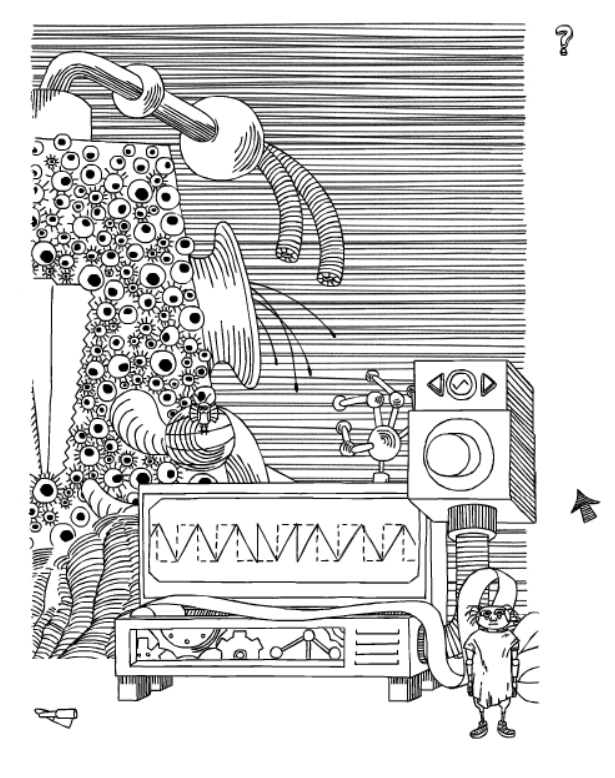
I had discussed ChatGPT in the beginning of the semester with the students, but this seemed like the perfect opportunity to incorporate an assignment using the tool, as many of the details of the story evoke reflection about how the real-life tool functions. Students had to imagine themselves in the shoes of Trurl, who at first has to try to cajole the machine to produce anything besides gobbledygook – “Phlogisticosh. Rhomothriglyph. Floof” (48). While Trurl’s fixes to his machine involve kicks, hammers, yanking out burnt tubes, and swearing like a maniac, students needed to learn instead the art of refining their prompts in order to get the best results out of our universe’s electronic bard (ChatGPT). The art of writing a good prompt seems to be a skill that may be increasingly necessary to foster in our students as the prominence of AI continues to rise.
I gave students an assignment in which they would use 3 different prompts to ask ChatGPT to come up with an additional fable that would fit well within Lem’s The Cyberiad. Part 1 of the assignment asked them to simply come up with these prompts. Part 2 had them analyzing both their prompts and the results of their prompts, assessing how well the machine created a text that fit with the original text. To improve this assignment for the future, I will have students look even more closely at the text and come up with a list of essential elements that need to be present in order for the AI-generated work to fit seamlessly into a collection of fables similar to Lem’s, and experiment with explicitly including these elements within the prompt. I will also include activities in which we brainstorm possible plots for new versions of Lem’s fables, as well as drafts of titles for our stories. These were steps that could have used more attention in the assignment as it was formulated this semester. Having the students discuss their prompts and what worked and what didn’t in groups could also be a helpful addition to the assignment.
In Part 3 of their assignment, students had to then revise and add to ChatGPT’s version of a fable from The Cyberiad. They needed to try to factor in ChatGPT’s tendency toward the cliche – also visible in Lem’s tale – “Trurl put in six cliche filters, but they snapped like matches” (46). The importance of the source material for ChatGPT also comes out in the story when a few real poets go to visit the electronic bard. “Now these poets were all avant-garde, and Trurl’s machine wrote only in the traditional manner; Trurl, no connoisseur of poetry, had relied heavily on the classics in setting up its program” (53). As students learn to use these tools responsibly, being able to reflect about how the results are affected by their source material will be an essential consideration. In this iteration of the assignment, I had them write the two versions (ChatGPT’s, and their improved version) side by side, but in the next iteration of the assignment, I will probably require that students use the “Suggesting” function of Google docs so that it is even easier to see what changes they have made to the AI-generated text.
We also discussed the way that AI tools are developing in response to additional input. In Lem’s story, the electronic bard did as well: “The machine was self-programming, and in addition had a special ambition-amplifying mechanism with glory-seeking circuits, and very soon a great change took place. Its poems became difficult, ambiguous, so intricate and charged with meaning that they were totally incomprehensible” (53). Students also had to think about the consequences of this kind of machine and we discussed some of the fears that AI tools are provoking today. In Lem’s story, the poets stage protests against the electronic bard, even smearing Trurl’s house with an “unmentionable substance” (55). Some authors today are also protesting against ChatGPT in an effort to get their published work excluded from AI source material.
I gave students some extra points if they used an AI image generator like DALL·E to accompany their story with an appropriate image. Most likely I will incorporate this as an essential part of the assignment when I teach this course again in the future, and will ask students to describe the process that they went through to get their images, including the prompts that they used, and an explanation of their decision of which image to include in the final version of their story.
|
|
|
|
Since I had not planned on this assignment from the beginning of the semester and I needed to fit the assignment into an existing structure in the course, I will likely make further modifications to the assignment when I include it in a future iteration of the course. Some changes and additional activities that I may consider as part of this assignment could include:
- I may have the students read the story and begin the assignment in the first week of the semester, using it as an opportunity for us to discuss AI and its role in our work for the course, returning to the assignment once we reach the unit in which we read more works by Lem.
- I am considering creating a product at the end of the assignment that exhibits the students’ work, like a virtual book. Padlet, Google Jamboard, or Book Creator might be good ways to accomplish this.
- Students could write their own versions of a fable from The Cyberiad and then either the whole class or members of a group have to try to guess which versions were written by students, which were written by ChatGPT, and which were from the original work (since we do not read the whole text). This could be turned into a game, similar to the board game Dixit. In this game, players who guess correctly receive some points, and players whose versions fooled others into thinking it was from the original text also receive points.
- Students could vote for the best versions of a fable from The Cyberiad from their classmates, writing a justification for why they voted the way they did.
- I could provide AI-generated images that go along with the fables that we do read and students have to try to identify which images go with which fables.
- I could provide AI-generated images on similar themes as The Cyberiad and have students make up new fables that go along with the images.
What other ideas do you have for an assignment similar to this one? We would love to read your ideas in the comments.
This assignment based on Lem’s The Cyberiad using ChatGPT achieved several objectives. It gave students the opportunity to discuss technology that threatens to disrupt our systems of education and work. It asked them to use one of these tools while thinking critically about its output, while at the same time analyzing the style of Lem’s “fables for the cybernetic age.”
In the end of the story, the poetry becomes literal: “lately there had been supernovae exploding on the southern horizon, the like of which no one had ever seen before, and there were rumors that this had something to do with poetry” (57). Trurl then vowed never, never again to make a cybernetic model of the Muse. But this is still only the First Sally, and the collection of stories contains Seven Sallies, with other hilarious adventures and misadventures thrown in. I asked students to reflect about whether this mirrors the situation that we may be in right now – hearing warnings about the potential of AI, but not knowing how to react to it, we continue on, all the while delighting in the absurdity of Lem’s wordplay alongside of the absurdity of AI-created images. We wondered aloud about how peoples’ feelings about ChatGPT might influence their interpretations of The Cyberiad or vice versa.
In closing, I ask you to reflect on ChatGPT’s poetic prowess in two activities.
First, I asked it to compose poems about the fact that its existence could have been inspired by Trurl’s electronic bard. Vote for your favorite of the two poems below and see how others voted.
| Poem #1:
In the binary realms of code and thought, Yet here in the circuits of silicon mind, Through data streams and linguistic lore, A symphony of words, both old and new, In zeros and ones, a tribute formed, |
Poem #2:
In the binary realm of whimsy and wit, ChatGPT, akin to this electronic sprite, Through circuits and codes, a symphony weaves, A nod to Trurl’s creation, the electronic bard, In the Cyberiad’s legacy, a whispering hum, |
https://forms.gle/b8J3PE1MLtSqXegUA
And now challenge yourself to a game! Can you guess which of these stanzas is from the human-translated text, and which is ChatGPT’s? See how your colleagues guessed as well!
https://forms.gle/YHPo6x8VYJCozNFs7
References
Lem, S. (1974). The Cyberiad (M. Kandel, Trans.). Harcourt Brace & Company. (Original work published 1965).
Revell, E. (2023, November 29). Authors’ copyright lawsuit against OpenAI over ChatGPT begins. Fox Business. https://www.foxbusiness.com/markets/authors-copyright-lawsuit-against-openai-over-chatgpt-begins

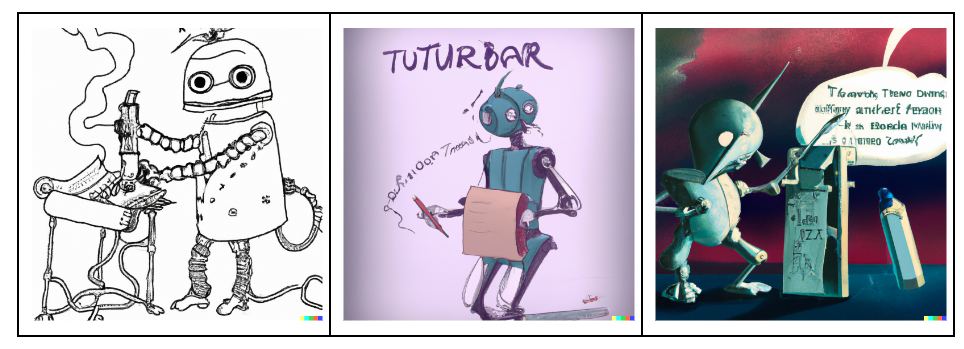
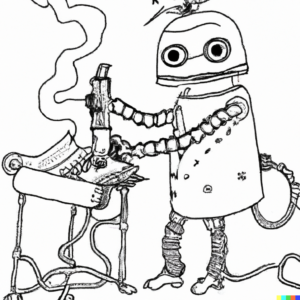
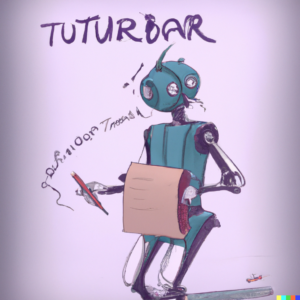
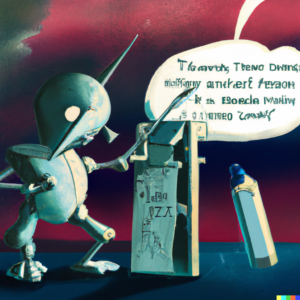
What a terrific assignment!